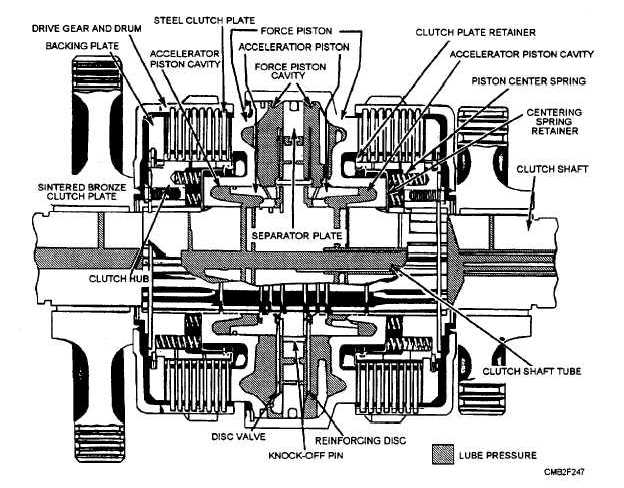FORWARD AND REVERSE HYDRAULIC CLUTCH OPERATION. - The forward and reverse hydraulic clutches actually have two clutches on a common shaft with a common apply force piston between them. The clutches allow the simple transfer of oil from the disengaging clutch into a cavity created by the engaging clutch. This allows a low volume of main pressure to actuate the clutch for high-speed shifting.
The heart of the clutch is contained in two pistons - the accelerator piston and the force piston. Pump oil volume is not needed to fill the applying clutch cavity, and only relatively low volume is needed to pressurize the clutch. In neutral, all accelerator and force piston cavities are filled with oil at lube pressure (10 to 25 psi). A selector valve, located on the top of the transmission case, directs the oil to the accelerator piston cavity and, in turn, to the force piston cavity. Once the pistons are filled with oil, they remain full under lube pressure. Other small cross-drilled passages furnish a constant supply of lube oil to the drive gear bushing, the drum assemblies, and the clutch hubs for distribution through the clutch plates. In neutral, neither clutch is engaged, the drive gear and drum assemblies are free. and no torque is transmitted through the clutch, as shown in figure 6-6.
Upon application of the clutch, main oil pressure (approximately 200 to 300 psi) is directed through the clutch shaft for the specific side of the clutch desired. The oil enters the force piston cavity causing the clutch to engage (fig. 6-7). When engaged, the clutch holds the gear stationary in relation to the shaft. Power then flows from the shaft, via the clutch, to the gear.
When the transmission is returned to neutral, an immediate pressure drop occurs within the disengaging accelerator piston cavity and the compressed piston centering springs return the common apply force piston to its centered position or neutral.
GEAR SHIFTER MECHANISM. - On many older models, the gearshift lever is connected through

Figure 6-6. - Flow of oil through the clutch in NEUTRAL position.
Continue Reading